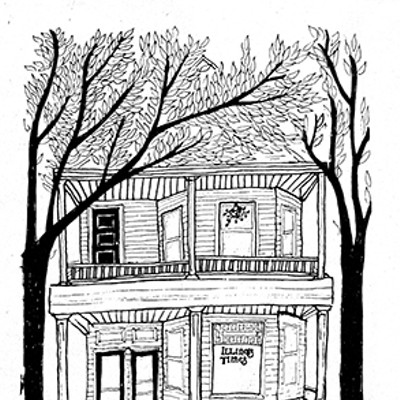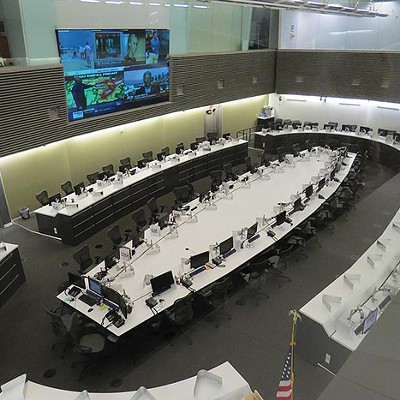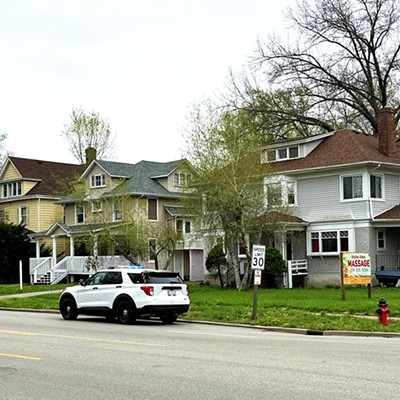Positive spillovers
What are public universities for?

[
{
"name": "Air - MedRect Combo - Inline Content 1",
"component": "11490391",
"insertPoint": "3",
"requiredCountToDisplay": "1",
"parentWrapperClass": "fdn-ads-inline-content-block"
},{
"name": "Air - MedRect Combo - Inline Content 2",
"component": "11490392",
"insertPoint": "7",
"requiredCountToDisplay": "5",
"parentWrapperClass": "fdn-ads-inline-content-block"
},{
"name": "Air - MedRect Combo - Inline Content 3",
"component": "11490393",
"insertPoint": "12",
"requiredCountToDisplay": "9",
"parentWrapperClass": "fdn-ads-inline-content-block"
}
]
Illinois legislators aren’t the only people who have to borrow money to pay for services whose value they sometimes question. Tuition and fees at four-year public institutions in the U.S. rose nearly 400 percent in the 30 years after 1981 – after adjusting for inflation – and student debt is rising faster than the salaries college graduates are likely to earn when they get out. For the first time in living memory, some parents are asking, Is a university education worth what it costs?
A few lawmakers are asking the same question. State aid in all its forms has made public universities a bargain for Illinois students, but it is less clear that public higher ed is a bargain for its taxpayers as well. Today, subsidies to colleges and universities are regarded as a perk of citizenship, but the founders of the Illinois higher ed system saw them as investments whose payoff was better citizens and more capable earners. Such spending still has such results, sometimes. More often, making a degree affordable to everyone has meant spending on students who have no interest in or aptitude for college work and who make bad choices with other people’s money – fit training for careers in the General Assembly perhaps, but not for the real world.
Then there are the Illinois graduates who leave the state, thus using their educations to benefit taxpayers in other places. This educational balance of payments seems to be slightly in Illinois’ favor, at least as measured by the relative numbers of degreed adults who migrate into (thanks, Chicago) and out of the state. One has to wonder, however, whether the numbers on net migration tell the whole story about value. I would guess that Illinois exports its best young minds to places like California or Massachusetts and gets the not-quite-best of other states in return.
Take a look at any list of graduates of achievement from the University of Illinois at Urbana-Champaign. In the tech world alone, one of the cofounders of Mosaic (begetter of the Netscape browser, and begetter of JavaScript) came out of the U of I. So did the founders of YouTube, Oracle (the Intel of server software) and PayPal. Every one of them now lives and works in California, and while none is an ornament to that state’s culture, they do generate lots of tax money for public use.
Educated elites everywhere are footloose as never before. In Hungary, students receiving state-sponsored university places have been told they must remain in Hungary after graduation; the longer they studied at state expense, the longer they have to stay, up to 10 years. The national government also announced recently that it would continue to fund study of in-demand subjects like engineering but drastically reduce support for other subjects such as economics and law whose graduates glut the market and are thus a drag on its social benefits system.
To achieve the same end, Americans tend to rely on free-market incentives such as free or reduced tuition to stay-at-home students in some fields. A state commission in Florida recently proposed charging lowering tuition to students pursuing degrees most needed for Florida’s job market. This policy would seem to make sense, but then a lot about Florida life only seems to make sense. The real beneficiaries of job-focused higher ed are companies that thus have their training done at taxpayer expense. George Mason University economics prof Alex Tabarrok insists that it would be better to target educational subsidies in ways that benefit taxpayers, not employers. Public subsidies should target fields in which education has the greatest “positive spillovers,” that is, fields whose practitioners return more of value to the state than the taxes they pay.
Exactly. The Illinois system was justified, backers argued, because classics-based traditional college learning was irrelevant to the needs of a growing state – or rather of a growing nation. The U of I was founded through federal land grant legislation that called for training in agriculture and the “mechanic arts.” (The U of I’s original name, remember, was Illinois Industrial University.)
Today’s Illinois is a populated urban state whose needs, while just as pressing, have dramatically changed in nature. Building a stronger economy needs technical training, but building a better state needs more and better social workers, teachers, criminologists, issues advocates, musicians, linguists, public administrators, public interest attorneys, urban planners, public health specialists, even, yes, journalists. Illinois is among the many that offer loan forgiveness to students preparing for a few such careers who stay in the state to practice their trades upon graduation; all too typically, the programs are under- or unfunded.
If the General Assembly ever stops arguing about how Illinois can afford the education it is already paying for and begins to ask how it might pay for the education it needs, it might start from this premise: What industry needs, industry ought to pay for, through private training academies and institutes. Public universities meanwhile should become public in focus as well as funding.
Contact James Krohe Jr. at [email protected].
A few lawmakers are asking the same question. State aid in all its forms has made public universities a bargain for Illinois students, but it is less clear that public higher ed is a bargain for its taxpayers as well. Today, subsidies to colleges and universities are regarded as a perk of citizenship, but the founders of the Illinois higher ed system saw them as investments whose payoff was better citizens and more capable earners. Such spending still has such results, sometimes. More often, making a degree affordable to everyone has meant spending on students who have no interest in or aptitude for college work and who make bad choices with other people’s money – fit training for careers in the General Assembly perhaps, but not for the real world.
Then there are the Illinois graduates who leave the state, thus using their educations to benefit taxpayers in other places. This educational balance of payments seems to be slightly in Illinois’ favor, at least as measured by the relative numbers of degreed adults who migrate into (thanks, Chicago) and out of the state. One has to wonder, however, whether the numbers on net migration tell the whole story about value. I would guess that Illinois exports its best young minds to places like California or Massachusetts and gets the not-quite-best of other states in return.
Take a look at any list of graduates of achievement from the University of Illinois at Urbana-Champaign. In the tech world alone, one of the cofounders of Mosaic (begetter of the Netscape browser, and begetter of JavaScript) came out of the U of I. So did the founders of YouTube, Oracle (the Intel of server software) and PayPal. Every one of them now lives and works in California, and while none is an ornament to that state’s culture, they do generate lots of tax money for public use.
Educated elites everywhere are footloose as never before. In Hungary, students receiving state-sponsored university places have been told they must remain in Hungary after graduation; the longer they studied at state expense, the longer they have to stay, up to 10 years. The national government also announced recently that it would continue to fund study of in-demand subjects like engineering but drastically reduce support for other subjects such as economics and law whose graduates glut the market and are thus a drag on its social benefits system.
To achieve the same end, Americans tend to rely on free-market incentives such as free or reduced tuition to stay-at-home students in some fields. A state commission in Florida recently proposed charging lowering tuition to students pursuing degrees most needed for Florida’s job market. This policy would seem to make sense, but then a lot about Florida life only seems to make sense. The real beneficiaries of job-focused higher ed are companies that thus have their training done at taxpayer expense. George Mason University economics prof Alex Tabarrok insists that it would be better to target educational subsidies in ways that benefit taxpayers, not employers. Public subsidies should target fields in which education has the greatest “positive spillovers,” that is, fields whose practitioners return more of value to the state than the taxes they pay.
Exactly. The Illinois system was justified, backers argued, because classics-based traditional college learning was irrelevant to the needs of a growing state – or rather of a growing nation. The U of I was founded through federal land grant legislation that called for training in agriculture and the “mechanic arts.” (The U of I’s original name, remember, was Illinois Industrial University.)
Today’s Illinois is a populated urban state whose needs, while just as pressing, have dramatically changed in nature. Building a stronger economy needs technical training, but building a better state needs more and better social workers, teachers, criminologists, issues advocates, musicians, linguists, public administrators, public interest attorneys, urban planners, public health specialists, even, yes, journalists. Illinois is among the many that offer loan forgiveness to students preparing for a few such careers who stay in the state to practice their trades upon graduation; all too typically, the programs are under- or unfunded.
If the General Assembly ever stops arguing about how Illinois can afford the education it is already paying for and begins to ask how it might pay for the education it needs, it might start from this premise: What industry needs, industry ought to pay for, through private training academies and institutes. Public universities meanwhile should become public in focus as well as funding.
Contact James Krohe Jr. at [email protected].
Illinois Times has provided readers with independent journalism for almost 50 years, from news and politics to arts and culture.
Your support will help cover the costs of editorial content published each week. Without local news organizations, we would be less informed about the issues that affect our community..
Got something to say?
Send a letter to the editor and we'll publish your feedback in print!






















